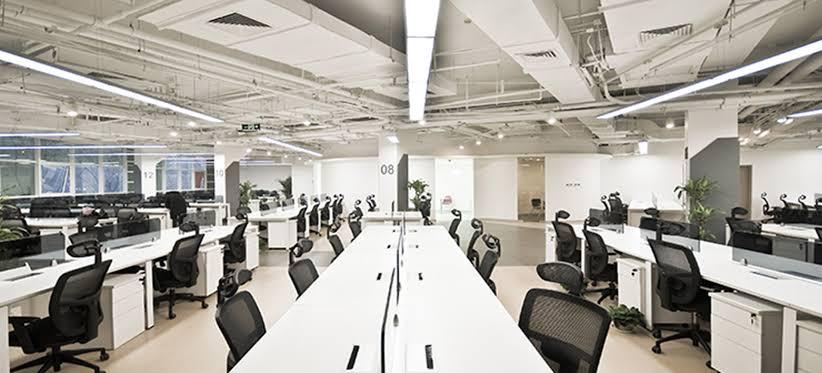WFH (Work From Home) the concept that has been forced upon because of the lockdown will have long lasting ramification. It will have a major impact on office demand.
By Varun Singh
Commercial real estate did well even when the residential sector was facing problems. However, the coronavirus has now thrown a serious question towards its stability.
The lockdown has forced many organizations to go for WFH concept. Recently even TCS announced that up to 2025, TCS will ask a vast majority of 75% of its 4.48 lakh employees globally (including 3.5 lakh in India) to WFH.
Ashutosh Limaye, Director & Head – Consulting, ANAROCK Property Consultants, says, “The COVID-19 pandemic has been a major gamechanger, making WFH a respectable and even altruistic decision. There are at least three major benefits. First, companies can save a lot of revenue on office space occupancy. Secondly, WFH can be a major productivity enhancer as employees save the time which they would ordinarily spend on daily commutes. Thirdly and as a derivative of the second benefit, it can significantly boost employee wellbeing.

WFH is obviously not a catch-all solution – many business verticals and functions still require employees to work in an office setting. A large chunk of work needs constant monitoring and professional infrastructure which only an office setting can provide. Nevertheless, market dynamics are changing quickly now, says Limaye.
- Coworking – Coworking is likely to see subdued demand over the next few quarters, but will also see the fastest revival – the pandemic pressures will eventually ease out many businesses will look to restart in these flexible workspaces. Coworking spaces are not only the most cost effective, but also offer flexibility in terms of time period of rental agreements. Coworking spaces can be rented on a monthly, day-to-day and even hourly basis.
- Conventional Offices – Traditional office spaces are currently a source of worry for both tenants and landlords. This is because it is difficult to visualize and plan for a post-pandemic market scenario. However, when the Government’s focus shifts back to economic growth, it will roll out business-boosting incentives that will revive the fortunes of commercial office spaces quickly.
Monthly Per-desk Rentals in India’s Major Business Centres (Coworking and Conventional Offices)
Mumbai Metropolitan Region (MMR)
- Average monthly rentals in Grade A office spaces in CBD (central business district) areas like South Mumbai and Bandra Kurla Complex are anywhere between INR 18,000–27,000/desk/month for coworking spaces, and between INR 24,500–30,000/desk/month for conventional commercial Grade A offices. All non-Grade A office spaces in CBD areas are lower by at least 15-20%.
- Average monthly rentals in Grade A office spaces in SBD (secondary business district) areas like Lower Parel, Andheri Kurla Road range anywhere between INR 12,000–18,000/desk/month for coworking spaces, and between INR 15,000–18,000/desk/month for conventional commercial Grade A offices. All non-Grade A office spaces in SBD areas are at least 25-35% cheaper.
New Delhi
- Average monthly rentals in Grade A office spaces in CBD areas like Connaught Place range between INR 13,000–19,000/desk/month for coworking spaces and between INR 20,000–25,000/desk/month for conventional commercial Grade A offices. Non-Grade A office spaces in the CBD areas are at least 15-20% cheaper.
- Average monthly rentals in Grade A office spaces in SBD areas like South-East Delhi and Delhi International airport, East Delhi and North Delhi are anywhere between INR 5,000–10,000/desk/month for coworking spaces and between INR 10,000–20,000/desk/month for conventional commercial Grade A offices. Non-Grade A office spaces in SBD areas are lower by at least 25-35%.
Bangalore
- Average monthly rentals in Grade A office spaces in CBD areas like M.G. Road, Millers Road, Vittal Mallya Road and Residency Road are anywhere between INR 7,000–15,000/desk/month for coworking spaces and between INR 10,000–18,000/desk/month for conventional commercial Grade A offices. Non-Grade A office spaces in the CBD areas are lower by at least 15-20%.
- Average monthly rentals in Grade A office spaces in SBD areas like Koramangala, Bannerghatta, Hosur road, Electronic City etc. are anywhere between INR 3,600–8000/desk/month for coworking spaces and between INR 6,500–15,000/desk/month for conventional commercial Grade A offices. Non-Grade A office spaces in SBD areas are lower by at least 25-35%.
Pune
- Average monthly rentals in Grade A office spaces in CBD areas like Laxmi Road, Camp, Bund Garden, Koregaon Park, Shivaji Nagar etc. are anywhere between INR 4,750–9,500/desk/month for coworking spaces and between INR 10,000–12,500/desk/month for conventional commercial Grade A offices. Non-Grade A office spaces in the CBD areas are lower by at least 15-20%.
- Average monthly rentals in Grade A office spaces in SBD areas like Kalyani Nagar, Yerwada, Viman Nagar, Aundh, Baner etc. are anywhere between INR 3,600–7,200/desk/month for coworking spaces and between INR 8,000–9,000/desk/month for conventional commercial Grade A offices. Non-Grade A office spaces in SBD areas are lower by at least 25-35%.
Chennai
- Average monthly rentals in Grade A office spaces in CBD areas like Anna Salai, Nungambakkam, RK Salai are anywhere between INR 5,700–13,300/desk/month for coworking spaces and between INR 7,000–15,000/desk/month for conventional commercial Grade A offices. Non-Grade A office spaces in the CBD areas are lower by at least 15-20%.
- Average monthly rentals in Grade A office spaces in SBD areas like T.Nagar, Alwarpet, Kilpauk, Egmore, Chetpet, Royapettah, Kotturpuram etc. are anywhere between INR 5,400–8,600/desk/month for coworking spaces and between INR 7,500–10,000/desk/month for conventional commercial Grade A offices. Non-Grade A office spaces in SBD areas are lower by at least 25-35%.
Hyderabad
- Average monthly rentals in Grade A office spaces in CBD areas like Gachibowli, Madhapur, Manikonda, Kondapur etc. are anywhere between INR 4,750–7,650/desk/month for coworking spaces and between INR 6,000–9,000/desk/month for conventional commercial Grade A offices. Non-Grade A office spaces in the CBD areas are lower by at least 15-20%.
- Average monthly rentals in Grade A office spaces in SBD areas like Pocharan, Uppal etc. are anywhere between INR 3,600–6000/desk/month for coworking spaces and between INR 3,500–7,000/desk/month for conventional commercial Grade A offices. Non-Grade A office spaces in SBD areas are lower by at least 25-35%.
Noida
- Average monthly rentals in Grade A office spaces in Noida are anywhere between INR 4,750–9,500/desk/month for coworking spaces and between INR 6,000–10,000/desk/month for conventional commercial Grade A offices. Non-Grade A office spaces are lower by at least 10-20%.
Chandigarh
- Average monthly rentals in Grade A office spaces in the city are anywhere between INR 4,750–7,600/desk/month for coworking spaces and between INR 6,000–9,500/desk/month for conventional commercial Grade A offices. Non-Grade A office spaces are lower by at least 10-20%.
Work From Home – Not A Catchall Alternative
For India Inc, the evolution of the WFH option is at least as exciting as that of coworking – if not more, considering its multiple benefits. That said, it will not work for every type of company. Most major industries have functions which require a high level of centralized supervision as well as data security which are only available in a formal office setting. As is becoming evident in this trial by fire, video conferencing technologies have very distinct limitations, too.
Most employees depend on the infrastructure provided in their offices to do their work efficiently, and also require a formal office setting to get into ‘work mode’. While WFH is not a one-size-fits-all workplace alternative, social distancing norms are likely to remain in place for a while to come and more and more companies will need to consider this option.
Also Read: Construction work resumes at non-hotspot zones, MMR not to benefit









